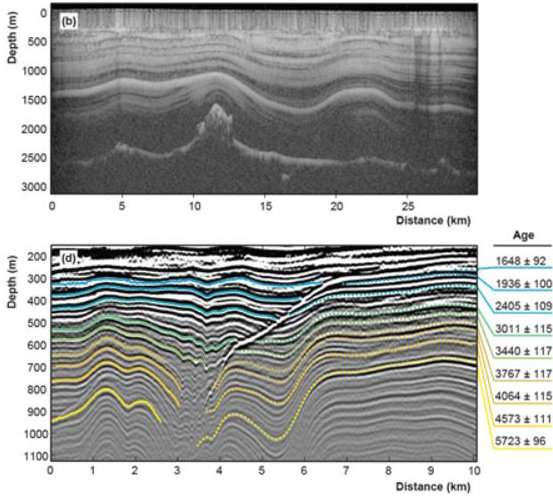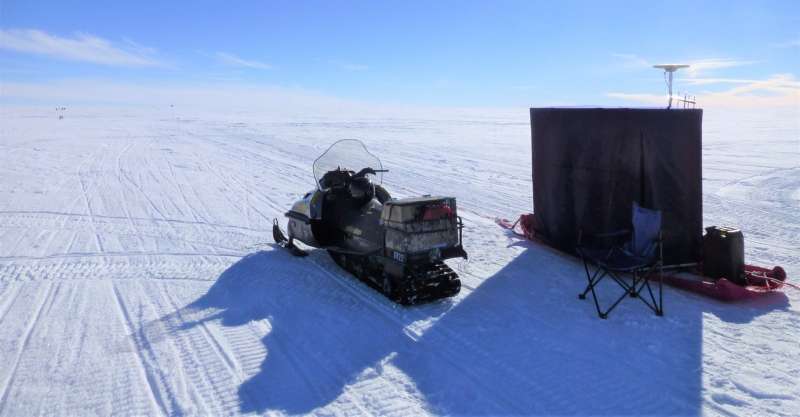Volcano under ice sheet suggests thickening of West Antarctic ice is short-term

A region of West Antarctica is behaving differently from most of the continent's ice: A large patch of ice there is thickening, unlike other parts of West Antarctica that are losing ice. Whether this thickening trend will continue affects the overall amount that melting or collapsing glaciers could raise the level of the world's oceans.
A study led by the University of Washington has discovered a new clue to this region's behavior: A volcano under the ice sheet has left an almost 6,000-year record of the glacier's motion. The track hidden in the middle of the ice sheet suggests that the current thickening is just a short-term feature that may not affect the glacier over the long term. It also suggests that similar clues to the past may be hiding deep inside the ice sheet itself.
"What's exciting about this study is that we show how the structure of the ice sheet acts as a powerful record of what has happened in the past," said Nicholas Holschuh, a UW postdoctoral researcher in Earth and space sciences. He is first author of the paper published Sept. 4 in The Cryosphere.
The data come from the ice above Mount Resnik, a 1.6-kilometer (mile-high) inactive volcano that currently sits under 300 meters (0.19 miles) of ice. The volcano lies just upstream of the thickening Kamb Ice Stream, part of a dynamic coastal region of ice that drains into Antarctica's Ross Sea.
Studies show Kamb Ice Stream has flowed quickly in the past but stalled more than a century ago, leaving the region's ice to drain via the four other major ice streams—a switch that glaciologists think happens every few hundred years. Meanwhile the ice inland of Kamb Ice Stream is beginning to bulge, and it is unclear what will happen next.
"The shutdown of Kamb Ice Stream started long before the satellite era," Holschuh said. "We need some longer-term indicators for its behavior to understand how important this shutdown is for the future of the region's ice."
The paper analyzes two radar surveys of the area's ice. One was collected in 2002 by co-authors Robert Jacobel and Brian Welch, using the ice-penetrating radar system at St. Olaf College in Minnesota, and the other in 2004 by co-author Howard Conway, a UW research professor of Earth and space sciences.
Conway noticed the mysterious missing layers and asked his colleagues to investigate.

"It wasn't until we had spent probably six months with this data set that we started to piece together the fact that this thing that we could see within the ice sheet was forming in response to the subglacial volcano," Holschuh said.
The study shows that the mysterious feature originates at the ice covering Mount Resnik. The authors believe that the volcano's height pushes the relatively thin ice sheet up so much that it changes the local wind fields, and affects depositing of snow. So as the ice sheet passes over the volcano a section missed out on a few annual layers of snow.
"These missing layers are common in East Antarctica, where there is less precipitation and strong winds can strip away the surface snow," Holschuh said. "But this is really one of the first times we've seen these missing layers in West Antarctica. It's also the first time an unconformity has been used to reconstruct ice sheet motion of the past."
Over time, the glacial record shows that this feature followed a straight path toward the sea. During the 5,700-year record, the five major coastal ice streams are thought to have sped up and slowed down several times, as water on the base lubricates the glacier's flow and then periodically gets diverted, stalling one of the ice streams.
"Despite the fact that there are all these dramatic changes at the coast, the ice flowing in the interior was not really affected," Holschuh said.
What the feature does show is that a change occurred a few thousand years ago. Previous UW research shows rapid retreat at the edge of the ice sheet until about 3,400 years ago, part of the recovery from the most recent ice age. The volcano track also shows a thinning of the ice at about this time.
"It means that the interior of the ice sheet is responding to the large-scale climate forcing from the last glacial maximum to today," Holschuh said. "So the long-timescale climatic forcing is very consistent between the interior and the coast, but the shorter-timescale processes are really apparent in the coastal record but aren't visible in the interior."
Holschuh cautions that this is only a single data point and needs confirmation from other observations. He is part of an international team of Antarctic scientists looking at combining the hundreds of radar scans of Antarctic and Greenland glaciers that were originally done to measure ice thickness. Those data may also contain unique details of the glacier's internal structure that can be used to recreate the history of the ice sheet's motion.
"These persistent tracers of historic ice flow are probably all over the place," Holschuh said. "The more we can tease apart the stories of past motion told by the structure of the ice sheet, the more realistic we can be in our predictions of how it will respond to future climate change."
More information: Nicholas Holschuh et al, Persistent tracers of historic ice flow in glacial stratigraphy near Kamb Ice Stream, West Antarctica, The Cryosphere (2018). DOI: 10.5194/tc-12-2821-2018
Provided by University of Washington

















